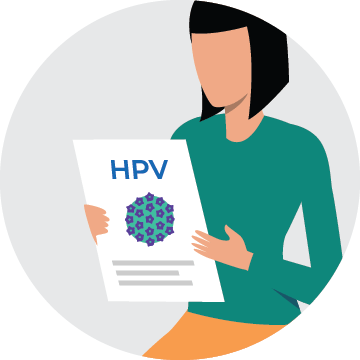HPV screening and follow-up pathway
Step 3: Initial triage and follow-up triage
 The recommendations outlined in these steps are intended to be actioned by decision-makers responsible for the delivery of cervical cancer screening and follow-up care.
The recommendations outlined in these steps are intended to be actioned by decision-makers responsible for the delivery of cervical cancer screening and follow-up care.
Learn more about intended audience and accountability.
Guidelines to support follow-up after a positive HPV test
To support jurisdictions who are planning to update their clinical guidelines, the Partnership has funded the Society of Gynecologic Oncology of Canada (GOC) to develop clinical guidelines on the management of participants with a positive HPV test and risk-based colposcopy and surveillance, with collaboration from and the Society of Canadian Colposcopists (SCC). Jurisdictions can use the guidelines to support processes for referral to colposcopy, including but not limited to establishing standard referral times, risk- and cytology-based considerations for referral to colposcopy, and recommendations for initial colposcopic exams and documentation. GOC guidelines are not intended to supersede local guidance.
Approaches to triage
 Recommendation: Develop best practice guidelines for triaging patients who test positive for HPV and for referring participants at higher risk of cervical cancer precursors to colposcopy.
Recommendation: Develop best practice guidelines for triaging patients who test positive for HPV and for referring participants at higher risk of cervical cancer precursors to colposcopy.
Key evidence and implementation considerations:
- HPV testing is more sensitive than cytology testing; however, cytology testing has higher specificity than HPV testing. A triage process such as cytology may increase specificity and avoid referral for additional follow-up and management for transient HPV infections or HPV infections not associated with cervical dysplasia.
- International jurisdictions have designed the triage component of the pathway to identify those who would clinically benefit from follow-up by using various approaches, such as retesting cycles and balancing test information sources.
- Retesting cycles are periods of waiting and retesting, typically after 6–12 months, for HPV and/or cytology when the first test result was positive. Retesting cycles provide a window for some HPV infections to resolve without treatment and for the participant to return to routine screening without treatment.1
- Other jurisdictions place different levels of reliance on the types of test information. In balancing test information sources, some jurisdictions place greater emphasis on cytology, while others are starting to rely more on the presence of HPV+ 16/18.
Approach to implementing triage varies among international jurisdictions
- In Australia, participants who are HPV+ 16/18 or HPV+ not 16/18 with a high-grade squamous intraepithelial lesion (HSIL) are deemed higher risk and referred to colposcopy. Participants HPV+ not 16/18 with a low-grade squamous intraepithelial lesion (LSIL) are deemed moderate risk, and there is one cycle of retesting at 12 months to determine if referral to colposcopy is needed.1
- In the UK, all participants with high-risk HPV+ (hrHPV+) results go to cytology, and two cycles of HPV retesting are completed to ensure the appropriate cases are referred to colposcopy.1
- The Netherlands appears to be more risk-averse in its approach, referring participants that are not negative for intraepithelial lesion or malignancy (NILM) and atypical squamous cells of undetermined significance (ASC-US+) result to colposcopy.1
 Recommendation: Work with lab partners to plan for high volumes of participants entering triage as a result of the higher sensitivity of HPV testing.
Recommendation: Work with lab partners to plan for high volumes of participants entering triage as a result of the higher sensitivity of HPV testing.
Key evidence and implementation considerations:
- Jurisdictions may see an initial surge in colposcopy referrals due to the sensitivity of HPV testing and the fact that both prevalent and incident infections will be detected in the early stages of testing. However, over the long term, referral rates are expected to decline with fewer cases of HPV and the implementation of triage.2
- Pathology/laboratory departments will also need to prepare for increased demand.
- Canadian Partnership Against Cancer. HPV primary screening and abnormal screen follow-up for cervical cancer environmental scan. 2021. Accessed January 19, 2022. Available from: https://www.partnershipagainstcancer.ca/topics/hpv-primary-screening-environmental-scan/
- Coldman AJ, Phillips N, van Niekerk D, et al. Projected impact of HPV and LBC primary testing on rates of referral for colposcopy in a Canadian cervical cancer screening program. J Obstet Gynaecol Can. 2015; 37(5):412-420. doi:10.1016/S1701-2163(15)30255-3


